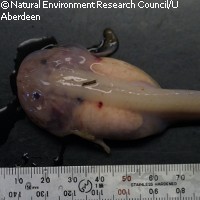Cameras catch deep-sea snailfish in action
When science and filmmaking mesh, the results are often surprising. Researchers from the University of Aberdeen, the National Environment Research Council in the UK and the University of Tokyo in Japan recently took cameras to one of the world's deepest ocean trenches 7,700 m below the surface of the Pacific ocean, and filmed groups of snailfish swarming over their bait. The film footage they came back with was rather unexpected. The research, part of the HADEEP project at Oceanlab, the subsea research facility of the University of Aberdeen, focused on life in the hadal region of the ocean. The hadal snailfish make their home thousands of metres below the surface, in trenches around the Pacific Ocean. Different species can also be found in the northwest Pacific, the South Pacific and the western coast of South America, specifically Chile and Peru. Professor Monty Priede commented that the videos exceeded the team's expectations of this research. 'We thought the deepest fishes would be motionless, solitary, fragile individuals eking out an existence in a food-sparse environment,' the Oceanlab chief said. 'But these fish aren't loners. The images show groups that are sociable and active -possibly even families - feeding on little shrimp, yet living in one of the most extreme environments on Earth,' he added. Extreme cold temperatures and water pressure, as well as total darkness make conditions difficult for the hadal snailfish, but they continue to survive. 'All we've seen before of life at this depth have been shrivelled specimens in museums. Now we have an impression of how they move and what they do. Having seen them moving so fast, snailfish seems a complete misnomer,' the professor explained. Thanks to the videos and images obtained with the scientists' cameras, we know that these snailfish feed on the thousands of tiny shrimp-like creatures that scavenge the carcasses of dead fish and detritus on the seabed, the research team said. 'We got some absolutely amazing footage from 7,700 metres. More fish than we or anyone in the world would ever have thought possible at these depths,' remarked project leader Dr Alan Jamieson from Oceanlab onboard the Hakuho-Maru research ship. The Oceanlab team developed and built the equipment used in the research. Its design was based on its capacity to withstand the extreme pressure at these depths. The researchers said the submersible camera platforms, or 'landers', took five hours to reach the depths of the trenches and remained on the seafloor for two days before they returned to the surface. The hadal region accounts for 45% of the total oceans depth but consists of very narrow trench systems, the majority of which are found around the Pacific Rim. The collision of the heavier oceanic tectonic plate with the lighter continental plates triggering a subduction zone is the source behind the creation of the deep trenches. These collisions can generate depths of more than 10,000 metres.
Countries
United Kingdom, United States

